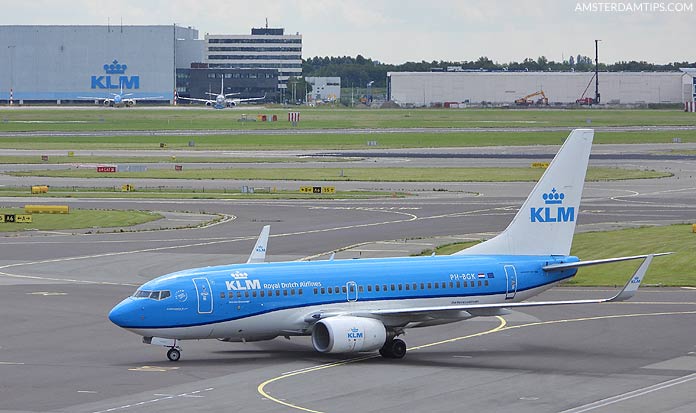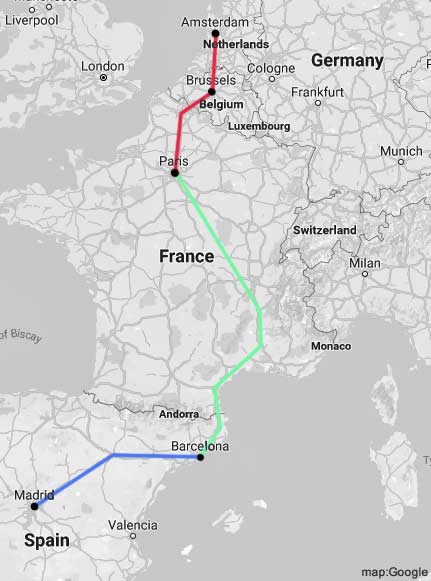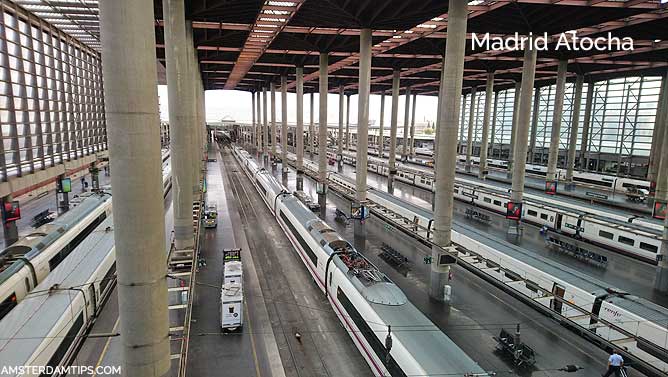
Madrid is the capital of Spain and is located some 1,450km south-west from Amsterdam.
Let’s look at the options for travel between Amsterdam and Madrid by air, train and bus.
1. Flights Amsterdam-Madrid
Flying is generally the quickest and easiest option. Flights between Amsterdam Schiphol (AMS) and Madrid Barajas (MAD) airports take around 2 hours 30 minutes.
Both Spain and the Netherlands belong to the Schengen Zone meaning you do not need a passport control check when travelling between Amsterdam and Madrid.
Madrid airport is connected to the city centre by train and metro. See here for Getting from Schiphol Airport to Amsterdam.
Dutch airline KLM (Skyteam alliance) flies up to 5x daily non-stop between Amsterdam and Madrid using Boeing 737 aircraft.

Spanish carrier Air Europa flies a 2x daily service between Amsterdam and Madrid – using both Boeing 787 and Boeing 737 aircraft. The Air Europa business class product on the Boeing 787 is excellent and fares can be good value.


Iberia Express (Oneworld alliance) flies up to 2x daily between Amsterdam and Madrid using Airbus A320 series aircraft.
Return prices are broadly similar between the airlines and start from around €130 – not including checked luggage. A business class return with Air Europa is priced from around €340.
Other airlines that serve Amsterdam and Madrid indirectly are Air France (via Paris), British Airways (via London), Lufthansa (via Munich), Swiss (via Zurich) or Vueling (via Barcelona).
2. Amsterdam-Madrid by Train
There are no direct rail services between Amsterdam and Madrid and no plans in the future for such a service. However, it is possible to travel by rail from Amsterdam to Madrid using daytime services and making connections in Paris, France and Barcelona.
An overnight stopover in either Paris or Barcelona will be required.

There are 4 components to the Amsterdam-Madrid train trip via Paris and Barcelona:
(1) A Eurostar (formerly Thalys) high speed train between Amsterdam Central and Paris Gare du Nord which takes around 3 hours 20 minutes. Eurostar normally runs up to 11x daily and stops at Schiphol, Rotterdam, Antwerp and Brussels.
Eurostar single fares between Amsterdam and Paris start at €35 (Standard), from €75 (Comfort, 1st class seat-only) and from €150 (Premium, full 1st class service). Eurostar tickets can be easily booked at the NS International site or at the Trainline site here


(2) Transfer across Paris. The transfer across Paris between Gare du Nord and Gare de Lyon is achieved in about 30 minutes using the RER D line – it is just 2 stops, though you need to buy a separate ticket. Alternatively you can take a taxi.
(3) A direct TGV duplex train between Paris Gare de Lyon and Barcelona Sants which takes about 6 hours 45 minutes. The train makes stops at Valence, Nîmes, Montpellier, Narbonne, Perpignan, Figueres and Girona.
There are 2x daily services. The morning train departs Gare de Lyon at 0941 and arrives in Barcelona at 1631. To get this train would require an overnight in Paris.
Hotels close to Paris Gare de Lyon – Just opposite the station you will find the Novotel Gare de Lyon, the CitizenM Paris Gare de Lyon, and the Mercure Gare de Lyon TGV.
The afternoon service departs Paris at 1441 and arrives in Barcelona at 2127. So it is possible to do the entire Amsterdam-Barcelona train journey during the day using this train – but you will need to overnight in Barcelona before continuing to Madrid.
TGV one-way fares for Paris-Barcelona are priced from €39 (2nd class) or €59 (1st class) although finding the lowest fares can be a challenge, especially in the spring/summer season. Booking is open 4 months in advance.
You can book Amsterdam-Barcelona through fares or the separate Amsterdam-Paris (Eurostar) and Paris-Barcelona (TGV) components at the NS International site.
It is also possible to book tickets at the Trainline site – but note Trainline sometimes mixes in coach fares so make sure you choose only train options.
(4) A high-speed Spanish domestic train from Barcelona Sants to Madrid Atocha via Zaragoza. These run regularly through the day and the journey takes under 3 hours.
The Barcelona-Madrid domestic train route is one of the most competitive in the world with the following 4 operators:
- RENFE AVE (Spanish Railways high-speed trains)
- RENFE AVLO (Spanish Railways low cost subsidiary)
- OUIGO (low cost SNCF French railways subsidiary using high-density TGV trains)
- Iryo (a consortium of Air Nostrum & Trenitalia which uses Frecciarossa trains)
Barcelona-Madrid one-way train fares can start as low as €7 (Avlo) and €9 (Ouigo). For a more comfortable trip however you could choose 1st class on AVE or Iryo which includes a meal served at your seat.
Barcelona-Madrid tickets (all 4 operators) are bookable at the Trainline site

Madrid-Amsterdam rail journey: Simply do the above 4 stages in reverse, deciding whether to overnight in Barcelona or Paris (or both).
3. Amsterdam-Madrid by Coach
Flixbus offers an Amsterdam-Madrid coach service with a change in Paris (running via Poitiers and Bordeaux) with one-way fares from around €60. Journey times are 24-27 hours and the Flixbus stops are at Amsterdam Sloterdijk and Méndez Álvaro in south Madrid.

Amsterdam Resources
Looking for a convenient hotel near Amsterdam Central station? Check out the stylish Kimpton-De Witt which is a short walk from the station. For those on a budget the Ibis Amsterdam Centre is literally on top of the western edge of the station platforms.
The Iamsterdam City Card (1-5 days) offers free entry and discounts to numerous Amsterdam museums and attractions. It also includes a free public transport pass, a canal cruise and bike rental as well. You can order your Iamsterdam City Card online here
Madrid Resources
In Madrid you can book your hotel with Booking.com here. For a selection of tours and attractions in Madrid book with GetYourGuide here
This article was originally published in 2013 and has continuously been updated. Last update 13 February 2024.
Links on AmsterdamTips.com may pay us an affiliate commission.



